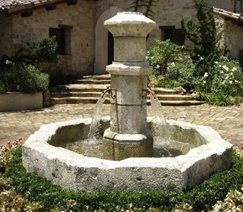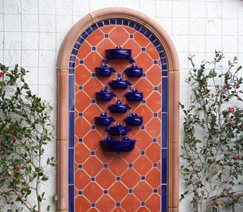Fountain Design Tips from an Industry Expert
Bill Rose, a forty-year fountain veteran, shares his insights
Bill Rose has been designing fountains for more than 40 years. "It all started in 1968 when I worked for Valley Crest Landscape and had the opportunity to design and install a fountain for a model home," he recollects. He also created one of the first pondless fountains in the 70's. Ever since, Rose has been on the cutting edge of fountain design. Now, through his company Fountains Unique, he spends a majority of his time providing high quality fountain spouts and accessories for others in the industry.
What do you love about fountains? Fountains have many benefits. First, is the soothing sounds they produce. Studies have been done showing that the sound of flowing water lowers stress levels. Second, fountains captivate people's attention, making them a great focal point for a garden, courtyard or patio. Lastly, I love fountains because designing them is an outlet for my own creative expression.

A fountain basin must be large enough to accommodate splash. Pictured is the French Courtyard Style Fountain made of carved stone.
What are the most common mistakes when it comes to fountain design? The number one mistake is no pre-planning. Lack of planning leads to splash and water replenishment problems that often result in an unused fountain. If a fountain basin is too small water will splash out causing muddy flower beds or wet, unsightly and unsafe pavement. The fountain will also lose water quickly which will result in a burned out pump. In order to avoid a splash problem, plan for a large enough catch basin (use the formula at right). If you are dealing with an existing splash problem, you can build the walls of the basin up higher to keep the water from escaping.
| Fountain Spash Formula: Height of falling water X .75 = splash radius Example: 36" X .75 = 27" splash radius |
Another common fountain mistake is plumbing the spout outside the wall. When this is done, the mask, spout or other accessory that is attached will be raised off the wall, leaving a strange gap. Many installers realize this mistake after the fact and end up having to chip back into the wall and fix the plumbing. Knowing that the connection for a spout is made inside the wall will help you avoid this problem.
What type of fountain do you recommend for a small space? Wall fountains are incredibly popular because they require a ¼ of the space required for a freestanding fountain. In 2010 we designed a wall fountain with a series of half cups that spill over into an underground reservoir. The fountain is very low maintenance because of its design. The underground reservoir is equipped with a float valve that automatically replenishes the water level if it gets low.
| Wall Fountain Tip: Be sure to use half bowls with scuppers that allow the water to pour out in a nice stream. Using a bowl without scuppers will cause water to dribble down the face, which will spoil the look and sound of a fountain. |
What materials do you recommend for fountain construction? For our spouts & wall bowls, the primary material is bronze, but some of our larger more elaborate fountains are made from carved stone, while some of our basins are cast from concrete. Here in the West there are very few restrictions on what materials to use for a fountain because we do not have to worry about hard freezes. If you live in an area that gets very cold you will need to use a frost proof material. Impruneta terracotta from Italy is frost-proof and we use a special concrete mix designed to withstand the cold.
What makes your company, Fountains Unique, different from other fountain companies? We offer over 80 spouts & wall bowls in a variety of designs and materials. Sixty of these are proprietary; you can't get them anywhere else. Our custom designs are sculpted by hand and then turned into molds. When you order a product from us you know that it is high quality and truly unique.
Bill Rose Fountains Unique
Laguna Hills, CA
|
Contributing Author: Sarah Hutchinson, contributing writer for Landscaping Network |
Related:







